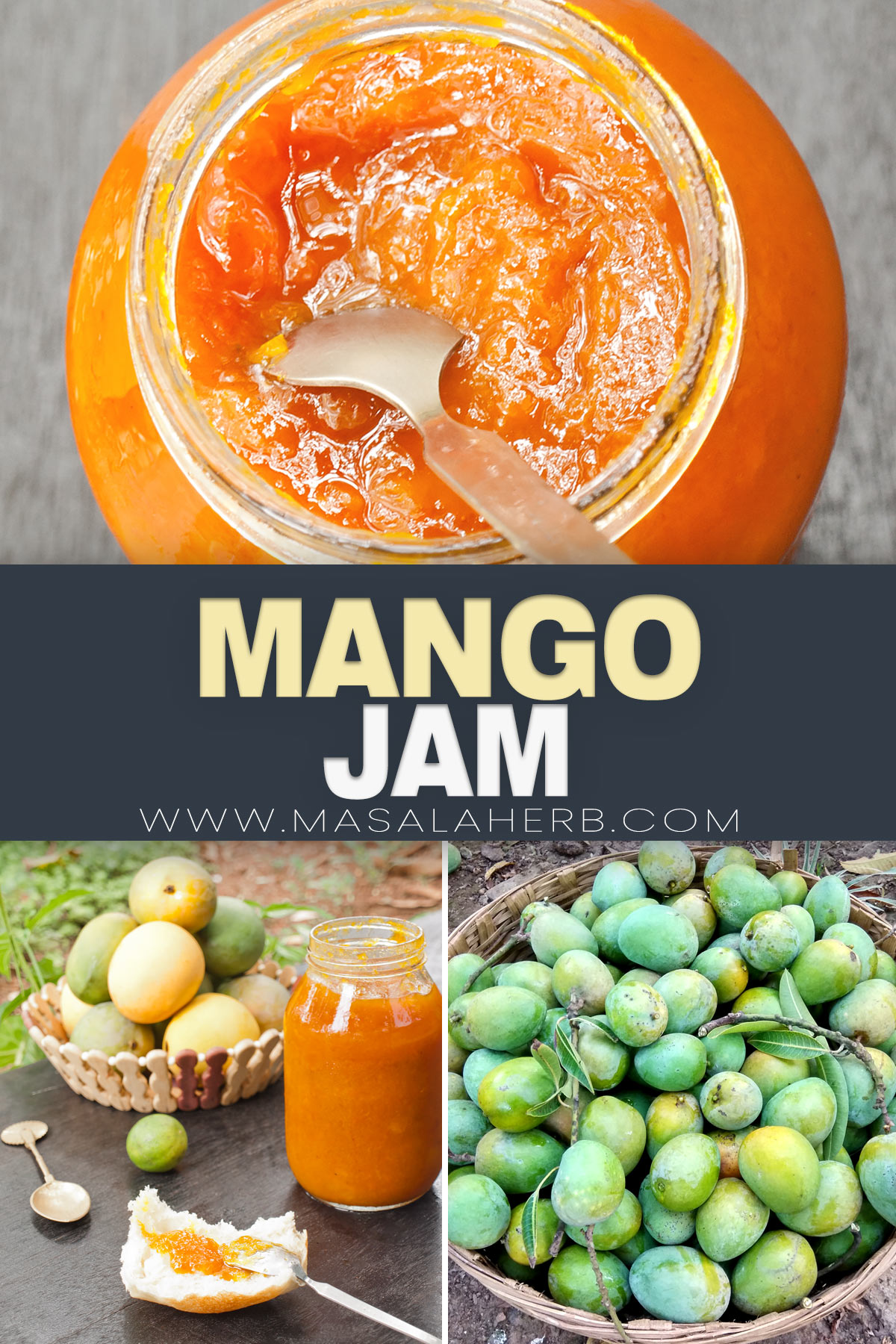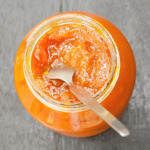
Enjoy the Mango season to the fullest with this homemade French mango jam preserve.
Everybody loves Mango Jam spread on a freshly baked bread for breakfast. Store the goodness of the season in form of mango preserves.
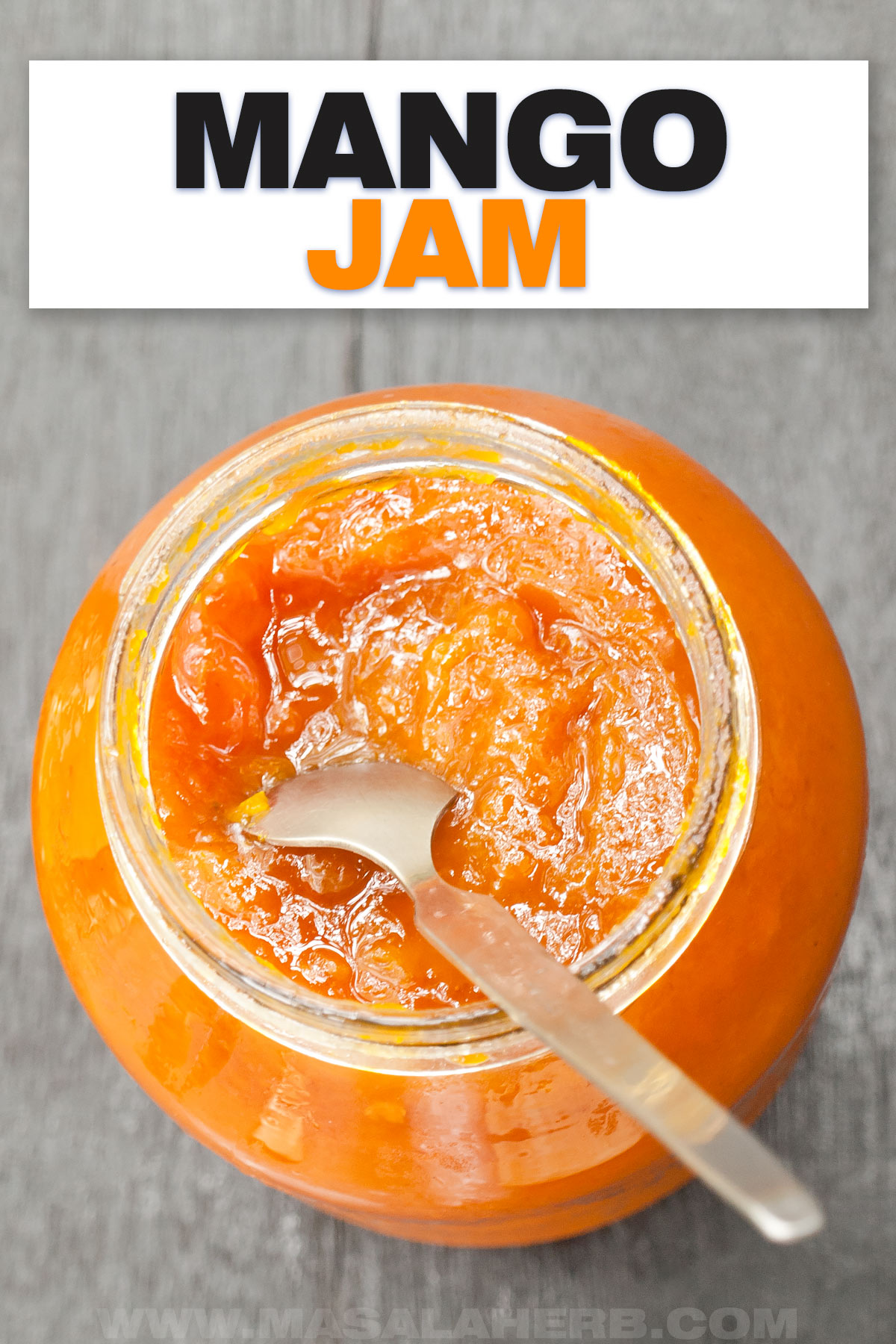

Global Food Recipes
with Spices and Herbs
Free E-Book available for a limited time. Grab yours now and get instantly inspired!
You missed out!
Jump to:
TL;DR
This jam is prepared as per our traditional preserving methods in France. Our French jams use only fruit and plain regular sugar and no artificial pectin.
We also don't water bath can our jams in France, BUT you are free to can your jars as per my water bath canning instructions to add another layer of preservation to your homemade jam.
Try to use flavorful non-fibrous mango varieties, as these are easier to work with when making mango jam.
Recommendation: For more French Jams see my mum's blueberry jam, our French strawberry jam and my extended jam recipe collection.
Ingredients
For your mango jam, you will need...
- Mangoes, fresh.
- Sugar — normal granulated sugar.
- Lime or Lemons (optional) — fresh. The juice and the cut halves are used because the natural pectin in the skin will help set the jam. Therefore, get lemons or limes which have not been treated with pesticides. Lemon juice and lemon halves are optional in this recipe, but they help set the jam with the natural pectin.
That’s it! No preservatives and a mango jam without artificial pectin! This Mango jam is with natural pectin only!
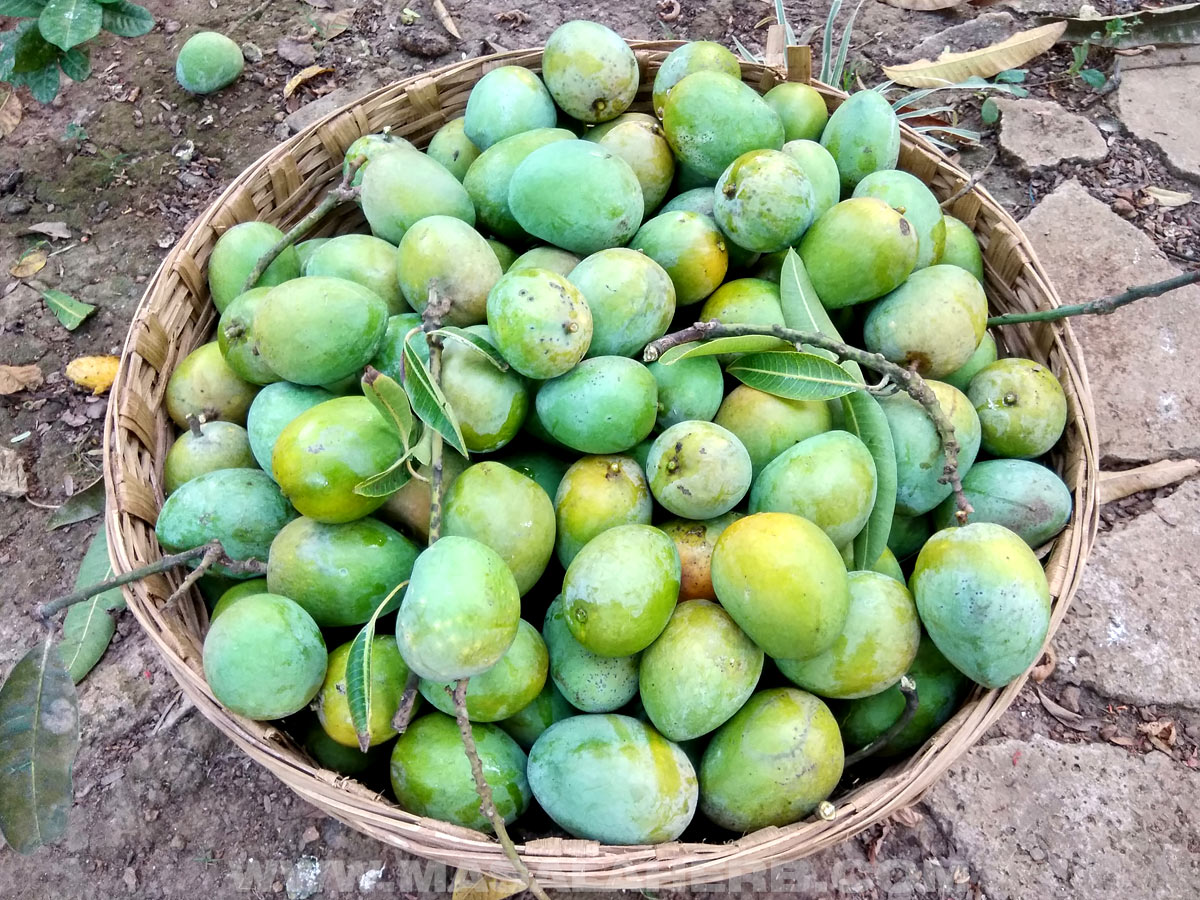
Choice of mangoes
Pick Mangoes that are:
- undamaged ripe but not hard raw.
- not moldy because your jam won't hold very long.
- with fewer fibers.
- sweet and flavorful.
Attention: If your Mangoes have more fibers than pulp, you are better off getting a different, more suited type of Mango for the Mango Jam Recipe. The Mangoes should have fewer fibers, that's why I choose mango varieties such as Alphonso, Bishops, Ataulfo or Kent for example. Also, make sure that your Mangoes are ripe but fresh. (See comment section for possible problems that may occur if wrong Mangoes are used).
You may have to use whole mangoes with the core to prepare the jam if you are getting mangoes with fibers.
This is because many mango varieties tend to have fibers and so to not have the strings in your jam, you cook the mango without the peel, but with the fruit flesh still attached to the core.
If you have a Mango variety without fibers (as I did in the steps below), you can cut the mango from the core and the mango pulp into smaller pieces to cook into mango preserves.
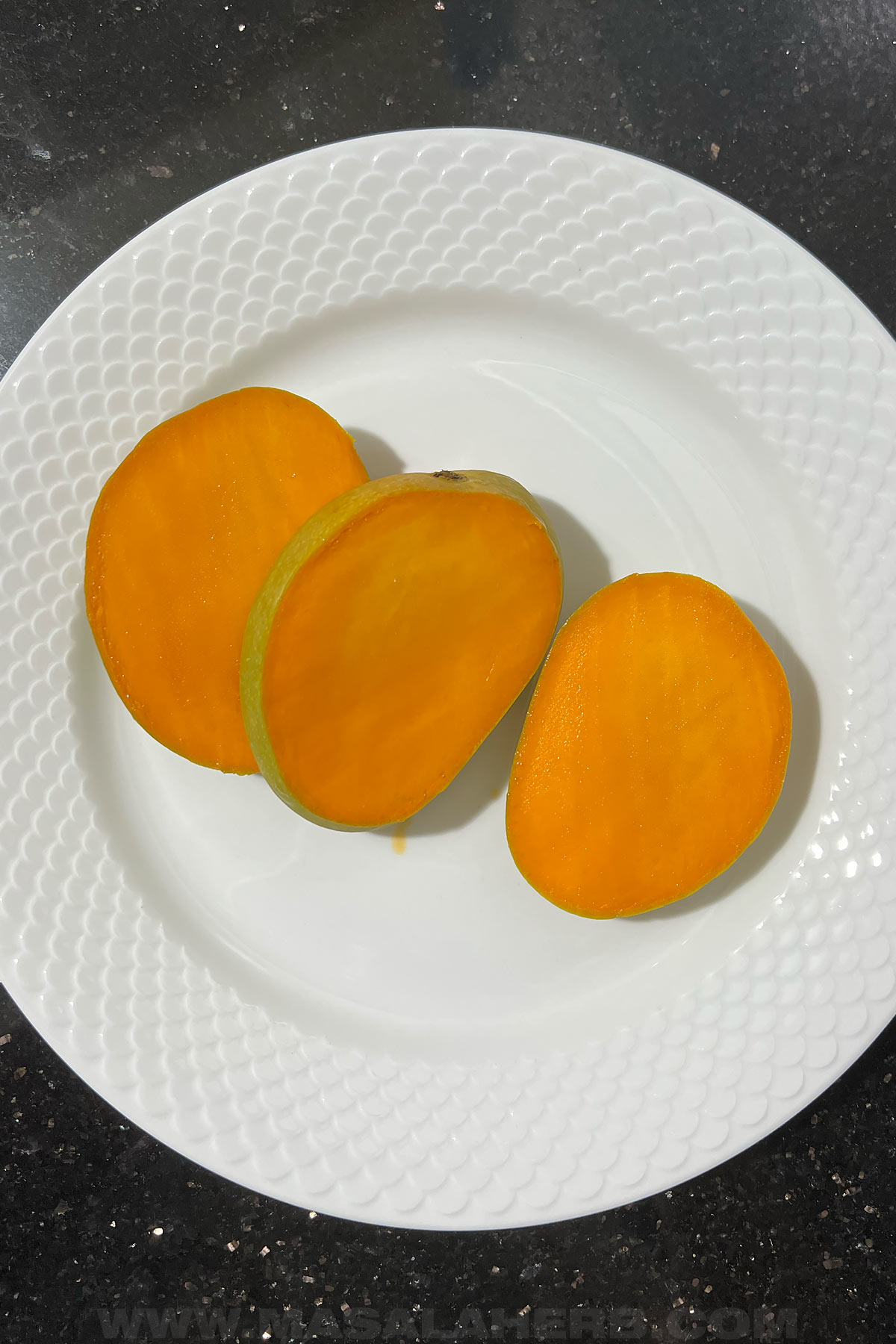
Some Mango types have plenty of annoying stringy fibers and I don't like those in my jam, so leaving the core can be a big bonus.
You can use different mango varieties to make your jam, which results in different interesting flavors.
But be aware that it's easier to deal with one mango variety when preparing this mango preserves recipe for the first time.
🔪 How to make the Jam?
To prepare our French mango jam, follow the main preparation steps.
The full printable recipe with instructions and ingredients can be found further below in the post.
Step 1
Peel your mangoes and cut the flesh from the seed core.
If you use a mango variety with fibers and strings, keep the fruit flesh on the core and just peel the mango.
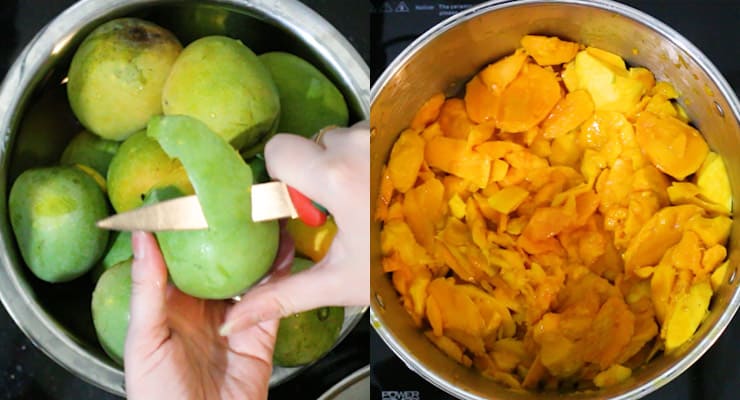
Step 2
Place mango with sugar into the pot and combine the ingredients.
Optional: You can add lemon/lime juice and the squeezed-out lemon halves to the jam too, as this can help the jam to set better.
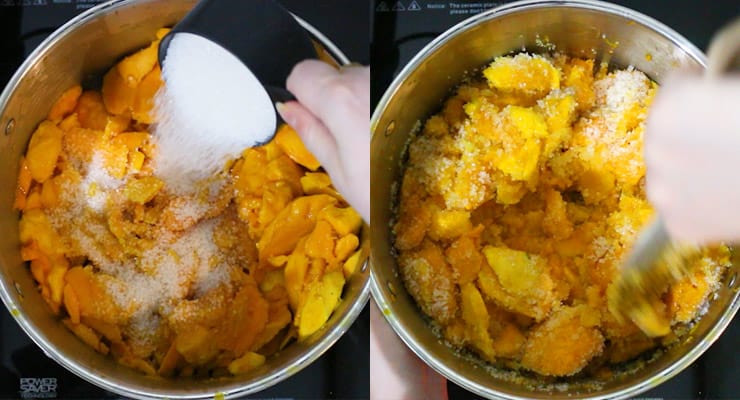
Step 3
Bring your jam to a rolling boil over a medium-high heat setting.
Continue to simmer your jam for a while over a medium heat setting so that it gets reduced and starts to appear translucent. This can take 30 mins.
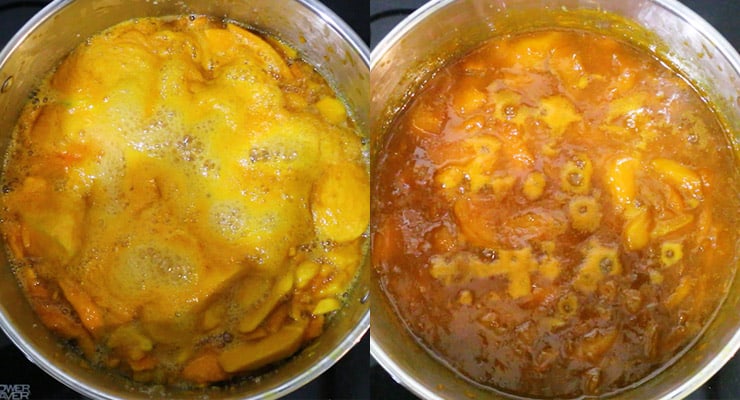
Step 4
Test if your jam is set with a thermometer or by checking if it's running on an ice-cold plate.
Step 5
Optional: Blend your jam smooth with a hand blender.
Fill up your sterilized jar with the hot jam up to the rim.
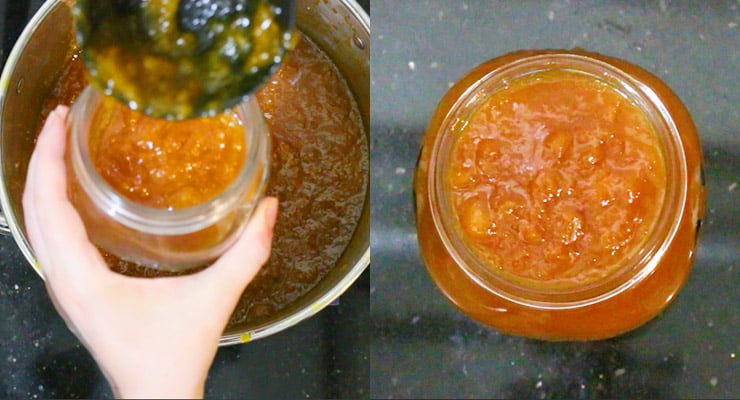
Step 6
Lock the jar with the lid and turn upside down to create a vacuum.
Allow to cool, label and store on a shelf in a cool and dry place.
📖 Recipe
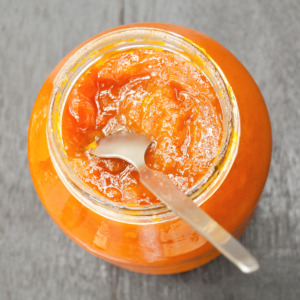
French Mango Jam Recipe
Ingredients
Mangoes with fibers (with seed core included)
- 7 medium-sized Mangoes with seed core, fresh
Mangoes without fibers
Instructions
- Start by peeling your mangoes and discard the peel. Cut the fruit flesh from the mangoes if you are using regular commercial mango varieties. If your mango variety has fibers and strings, don't cut the flesh off but rather leave it on the seed core. The fruit flesh will fall off the fibers and the seed core during the cooking process. *see Notes
- Pour all the sugar over the mangoes and mix everything well.
- This step is optional. Wash your lemon/lime and cut into half. Press out the juice and pour over the mangoes. Throw the 2 squeezed out lemon halves into the pot with the mangoes. Lemon skin adds natural pectin to the jam making and it helps to set the jam.
- Heat up, keep over a medium to high heat setting and bring your fruits with sugar to a rolling boil.
- Reduce heat and simmer until the fruits appear translucent and set. (Note, hot jam will always appear liquid, which is misleading, and it only sets when cooled down). Simmering down can take about 30 minutes.
- Optional: Mash or blend jam to desired consistency. You might like it chunky or not.
- Test jam setting. Use a thermometer in doubt: The setting temperature is 105 Celsius/220 Fahrenheit. You can also test if the jam is set by using a frozen plate or spoon and by dropping some hot cooked jam on the frozen plate. That will cool the drop of jam instantly, and you will be able to see whether the jam has set or not. If the jam is still running, cook it a bit more and repeat the test until the jam has set. Always keep an eye on the cooking jam as to not burn the jam.
- Pick out and discard the lime/lemon halves and if you used fibrous mangoes, then the seed core as well. *see notes
- Grab a clean, sterilized jar and fill it up to the rim with the jam.
- We drop some liquor (vodka, rum) into the lid to kill all the germs.
- Seal the jars and turn it upside down before you store the mango jam jars in a cool and dry place. Keeping the jam jars upside down creates a vacuum and helps in preserving the jam all the longer. Turn the jars upside once they are not that hot anymore (about 30 mins later).
- Make sure to label your jam with the jam name, date and best before date. The jam will be good for about 10 months if unopened. Store in the fridge once opened.
Notes
- When choosing mangoes, pick a mango variety with fewer fiber/strings and undamaged mango. If you use a mango variety which doesn't have fibers and only fruit flesh, cut off the fruit flesh from the seed core and discard the seed core. You only need to cook the seed core with the mangoes if the mangoes have fiber strings because you don't want those in your jam, and they remain on the seed core like a layer of hair.
- Use only untreated/pesticide free lime/lemon because the whole lemon halves are used to cook up the jam as it provides natural pectin.
- Store jars filled with jam in a dry, cool and dark place. Once you open the jars, store in the fridge.
- Only use sterilized jars when making homemade jams. You can sterilize jars by boiling them in water, by washing them in the dishwasher, or by placing them into the oven to heat up. Sterilizing means killing all germs.
- Half pint jars = to almost 250 ml jars. The base recipe requires 3 half pint jars, which is about 3 × 250 ml jars.
- You can reduce the sugar in this mango recipe, but you will need to consume the mango jam in the next 1–3 days. The sugar in the mango jam and the lime/lemon help the jam to preserve for months if ripe fresh mangoes are used.
- 1 medium Mango weighs about 200 grams/ 7 ounces with the seed core.
Equipment
- 1 Jam Pan (copper) or large stainless steel pot
- 1 Ice cold plate to test if it's set. Keep plate in freezer before peeling mangoes.
Nutrition
Storing
After filling up your jars with the jam, keep the jars upside down until the jars have cooled down a bit. Then turn them back up (or else you will have air bubbles forming inside).
At this point, you have the option to water bath can your jam. You can do this if you follow FDA guidelines in the US. We don't do this in France, but this step is beneficial if you live in a hot and humid place.
Store the jars on a shelf in a dry place, away from direct sunlight and humidity.
If you live in a tropical, humid or wet environment, store your jars in the fridge. You might want to do this in general if you are afraid of mold growth.
You can also freeze your mango jam filled jars.
Once you unseal a jar, keep the jam in the fridge. This is because the vacuum seal was broken so, from now onwards, your jam needs to be cooled so that no germs form.
Using your Jam
Make sure to always use a clean spoon to dip into the jam.
Don't lick your spoon and then dip it back into the jam. This is how you will have mold growing in your jam with your bacteria infecting it.
Close the jar, always well with the lid.
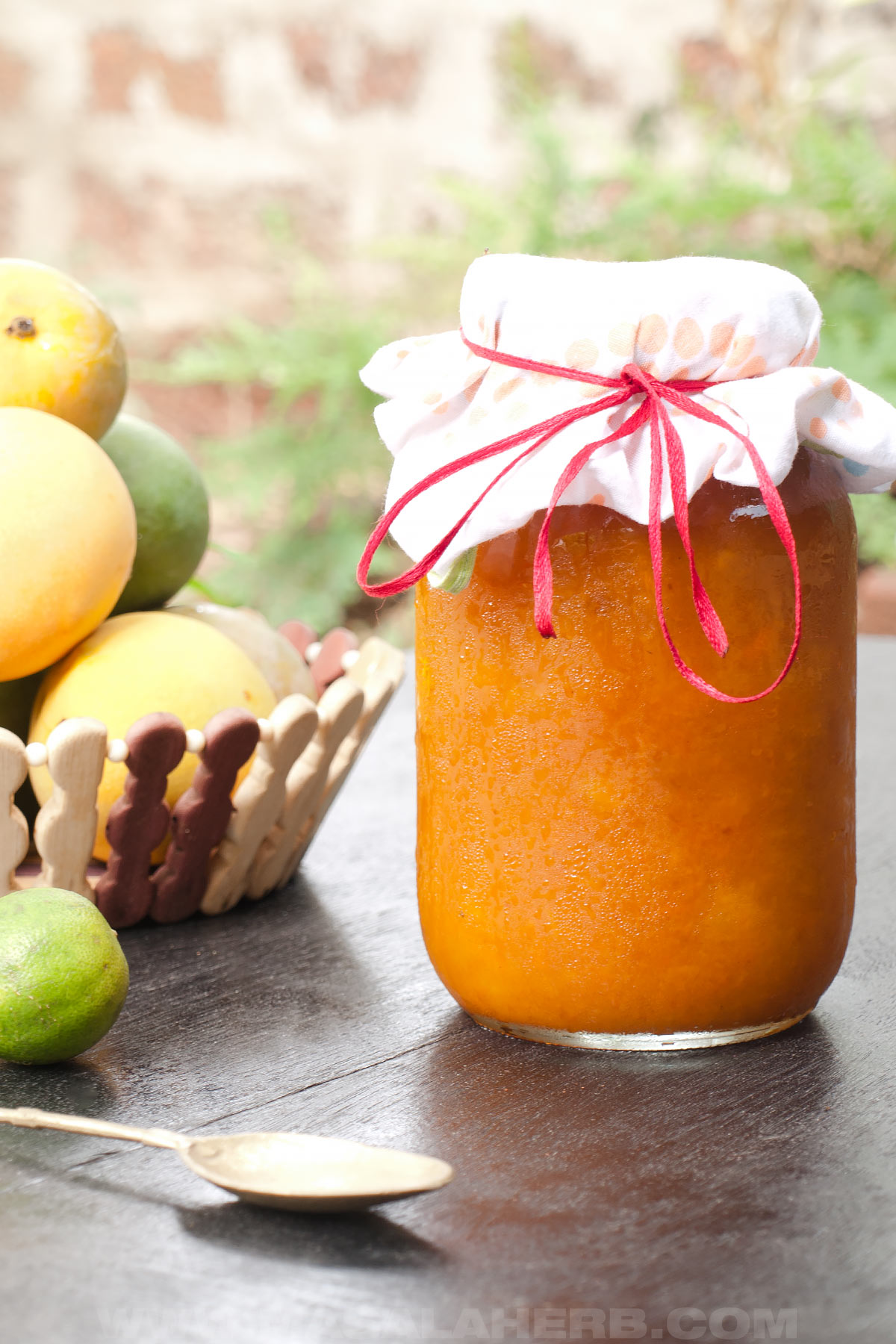
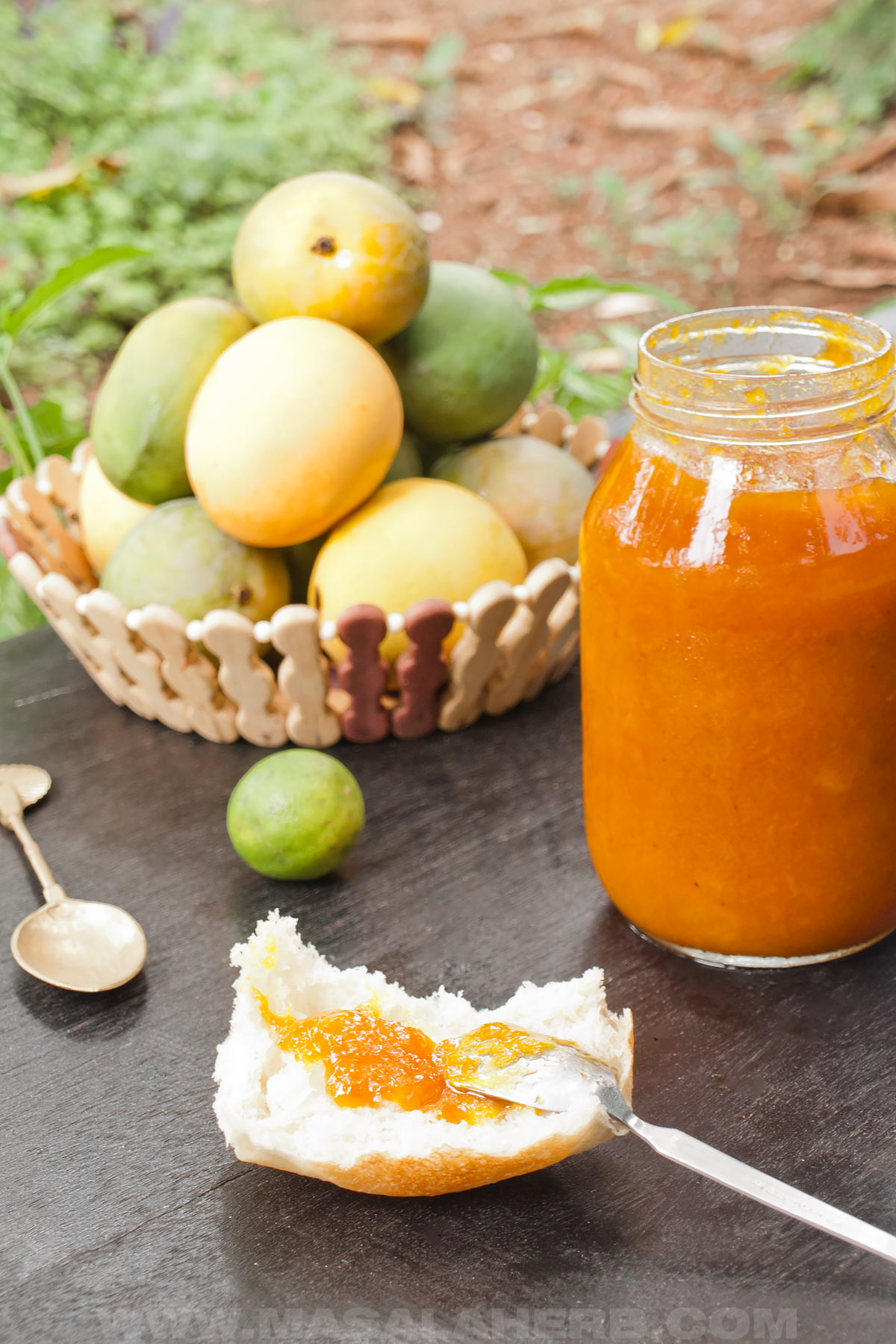
FAQ
If you are making jam for the first time, read through this section.
What's the jam setting temperature?
The Mango jam setting temperature is 105 Celsius/220 Fahrenheit. Use a candy thermometer if this is your first time making jam.
Why is my Mango jam runny?
These are some reasons why your Mango jam is not set and why it remains runny.
Low Pectin
Your Mangoes are naturally low in pectin.
Quick fix: Add 2-3 organic lime/lemon with the skin and juice.
That way, you add a load full of natural pectin to your mango jam!
Quantity
You tried to make a larger amount of mango preserves.
It's way easier to create a smaller batch of around 1 kilogram (2.2 pounds) of mango jam.
The more you make, the more you would have to adjust your ingredients, and that can complicate things in your jam making.
Sugar
You reduced the amount of sugar in the recipe because you thought it contained far too much sugar.
Don’t ever reduce the sugar in a jam recipe, especially when it’s without pectin.
The sugar has its place in the mango jam making.
Sugar preserves and makes sure that your mango jam doesn't turn bad.
Cooking
Your jam didn't cook to a rolling boil, or you didn't cook your jam long enough.
If you are new to jamming, use a thermometer and stick to the temperature mentioned above.
Your pot is not heating up uniformly.
Use a large, deep pot. The best are copper pots, copper tends to spread out the heat evenly and that can be very helpful when preparing jam from scratch.
Make sure to stir frequently too! Keep in mind, this mango jam recipe does not include artificially added pectin.
This Mango preserves recipe is prepared after the French jam making tradition.
Why is my Mango Jam hard?
Your mango jam got overcooked on high heat for a longer period of time.
A quick fix to a hard jam is to take it back to the pot, heat it up again, add water and just cook it slowly until it dissolves.
Then take the jam back to the jars and consume soon.
Once you add water to a jam, it won't hold that long, but at least you saved your jam.
Fixing a hard overcooked jam is trickier.
